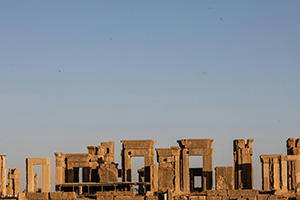History of Iran

Iran is one of the oldest nations in the world, with a history dating back tens of thousands of years. The country's first great city, Susa, was built on the central plateau around 3200 B.C.
In 559 B.C., the Persian Empire arose in southwestern Iran and conquered the Mesopotamians and Egyptians. The empire eventually extended from the Mediterranean Sea to what is now Pakistan, but it was conquered by the Greeks in 330 B.C.
Around 260 B.C., nomads called Parni ousted the Greeks and ruled for some 500 years. The Sassanids came into power in A.D. 224, and in A.D. 642, Persia became part of the Islamic Empire. In 1501, the kings, or shahs, of the Safavid Empire began their reign.
In the late 18th century, foreign powers, including Russia and Britain, took control of parts of Persia. In 1921, a Persian army officer named Reza Khan took control and sought to end outside influence. In 1935, he renamed the country Iran. His son, Mohammad Reza Pahlavi, became shah in 1941.
In 1979, many Iranians who felt Pahlavi was corrupt forced him to flee, ending the reign of the shahs in Iran. Since then, religious leaders have ruled the country. The first was Ayatollah Ruhollah Khomeini, whose ten years in power were marked by a long war with Iraq and tensions with the United States and many other nations. Khomeini died in 1989, but much of those tensions still exist today.
Women during revolution

The Islamic Revolution of 1979 brought seismic changes to Iran, not least for women. One area that has come under scrutiny is the way women dress and wear their hair - the old Shah, in the 1930s, banned the veil and ordered police to forcibly remove headscarves. But in the early 1980s, the new Islamic authorities imposed a mandatory dress code that required all women to wear the hijab.
Soon after taking power, Iran's new Supreme Leader Ayatollah Ruhollah Khomeini decreed that all women had to wear the veil - regardless of religion or nationality. On 8 March - International Women's Day - thousands of women from all walks of life turned out to protest against the law.
Though women were never officially banned from watching men's football matches in Iran, they are often refused entry to stadiums and some of those who have tried have been detained. Before the revolution, women were allowed to attend sporting events.
In the late 18th century, foreign powers, including Russia and Britain, took control of parts of Persia. In 1921, a Persian army officer named Reza Khan took control and sought to end outside influence. In 1935, he renamed the country Iran. His son, Mohammad Reza Pahlavi, became shah in 1941.
On September 16, 2022, the death of Mahsa Amini while in the custody of Tehran's religious morality police sent shockwaves through Iran and launched a revolutionary movement, characterized by the slogan "Woman, Life, Freedom".
The government quickly moved to suppress protests in cities across Iran, arresting more than 20,000 people and killing more than 500 young protesters. The regime subsequently employed facial recognition technology to enforce strict laws on wearing the hijab, resulting in the closure of numerous restaurants, shops, and even pharmacies who served uncovered women.
Yet despite this crackdown, the “Woman, Life, Freedom” movement is still alive today